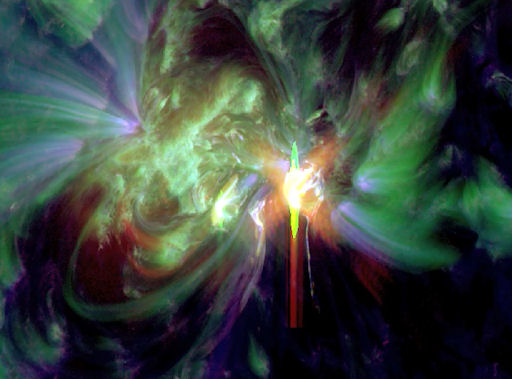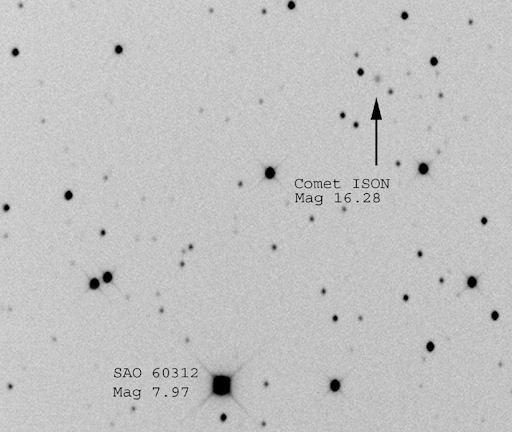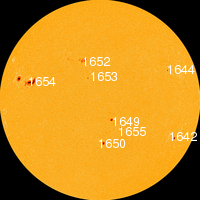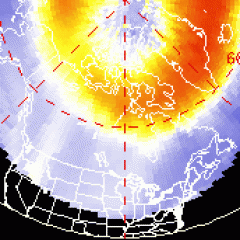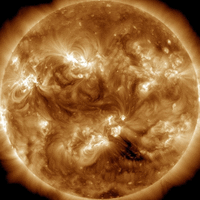SOLAR VARIABILITY AND TERRESTRIAL CLIMATE: A new report issued by the National Research Council, "The Effects of Solar Variability on Earth's Climate," lays out some of the surprisingly complex ways that solar activity can make itself felt on our planet. Get the full story from Science@NASA.
INCREASING CHANCE OF FLARES: Big sunspot AR1654 is growing more active. It is now crackling with M-class solar flares, such as this one recorded by NASA's Solar Dynamics Observatory this morning at 09:11 UT:
AR1654 is getting bigger as it turns toward Earth. Not only is the chance of flares increasing, but also the chance of an Earth-directed eruption.This could be the sunspot that breaks the recent lengthy spell of calm space weather around our planet. Solar flare alerts: text, voice.
Realtime Space Weather Photo Gallery
COMET ISON APPROACHES: Later this year, Comet ISON could put on an unforgettable display as it plunges toward the sun for a fiery encounter likely to turn the "dirty snowball" into a naked-eye object in broad daylight. At the moment, however, it doesn't look like much. John Chumack sends this picture, taken Jan. 8th, from his private observatory in Yellow Springs, Ohio:
"Comet ISON (C/2012 S1) is currently in the constellation Gemini, moving between the heads of the twins Castor and Pollux," says Chumack. "It is still pretty faint, near 16th magnitude, but don't be fooled by that. This could become one of the best comets in many years."
Comet ISON is a sungrazer. On Nov. 28, 2013, it will fly through the sun's outer atmosphere only 1.2 million km from the stellar surface below. If the comet survives the encounter, it could emerge glowing as brightly as the Moon, visible near the sun in the blue daylight sky. The comet's dusty tail stretching into the night would create a worldwide sensation.
Comet ISON looks so puny now because it is so far away, currently near the orbit of Jupiter. As it falls toward the sun in the months ahead it will warm up and reveal more about its true character. By the summer of 2013, researchers should know whether optimistic predictions about Comet ISON are justified. Possibilities range from "Comet of the Century" to disintegrated dud. Stay tuned!

![]()
Solar wind
speed: 329.1 km/sec
density: 5.1 protons/cm3
explanation | more data
Updated: Today at 1707 UT
![]()
X-ray Solar Flares
6-hr max: M1 1508 UT Jan11
24-hr: M1 0911 UT Jan11
explanation | more data
Updated: Today at: 1700 UT
![]()
![]()
![]()
Daily Sun: 11 Jan 13
![]()
![]()
Sunspots AR1652 and AR1654 have beta-gamma magnetic fields that harbor energy for M-class solar flares. Credit: SDO/HMI
![]()
![]()
![]()
Sunspot number: 145
What is the sunspot number?
Updated 11 Jan 2013
Spotless Days
Current Stretch: 0 days
2012 total: 0 days (0%)
2011 total: 2 days (<1%)
2010 total: 51 days (14%)
2009 total: 260 days (71%)
Since 2004: 821 days
Typical Solar Min: 486 days
Update 11 Jan 2013
The Radio Sun
10.7 cm flux: 169 sfu
explanation | more data
Updated 11 Jan 2013
![]()
![]()
![]()
Current Auroral Oval:
![]()
Switch to: Europe, USA, New Zealand, Antarctica
Credit: NOAA/POES
![]()
![]()
![]()
Planetary K-index
Now: Kp= 1 quiet
24-hr max: Kp= 1 quiet
explanation | more data
![]()
Interplanetary Mag. Field
Btotal: 2.3 nT
Bz: 0.3 nT south
explanation | more data
Updated: Today at 1707 UT
![]()
![]()
![]()
Coronal Holes: 11 Jan 13
![]()
![]()
There are no large coronal holes on the Earthside of the sun. Credit: SDO/AIA.

